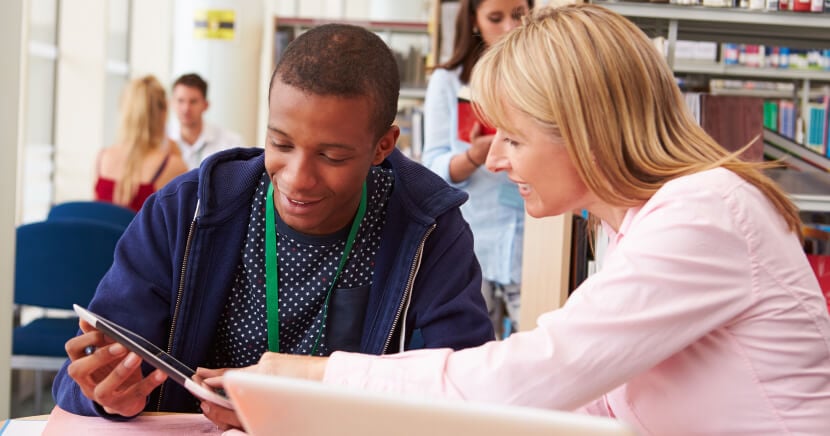Let's talk about the zone of proximal development!
Okay, most of us might not be familiar with that term, which we owe to Russian psychologist Lev Vygotsky, but fear not; you need not be an expert in educational research to easily grasp the concept.
Imagine three concentric circles, arranged like a target. The center circle — the bullseye, if you will — represents what a learner is capable of doing without any support. The outer ring represents what that same learner can't do, even with support. In between these two is the range where the learner is able to perform with support from a teacher or a peer with more knowledge or expertise. That in-between area is the zone of proximal development.
This concept is the root of collaborative learning, an educational approach in which students work together in groups to achieve a common goal or complete a task. Collaborative learning is based on the idea that education is enhanced and learning outcomes improved when group members engage in social interaction, discussion and shared problem-solving.
In the collaborative learning process, students often take on different roles within their groups, such as leader, facilitator, researcher or recorder, which helps to foster a sense of responsibility and cooperation.
Collaborative learning strategies encourage active participation in group work, critical thinking and the exchange of ideas among peers, ultimately leading to deeper understanding and retention of the material. Collaborative learning can occur both in traditional classroom settings and in online or virtual environments — and, as we'll see, libraries also have an important role to play
See also:
-
Academic librarians help students succeed, but student engagement is key
-
Faced with budget cuts, academic libraries must get creative with resources
Collaborative learning in higher education
It's easy to see how effective collaborative learning can be in a K-12 setting, but what about other educational settings, such as colleges and universities? In a higher-education context, collaborative learning can take many forms.
Here are a few ways that collaborative, active learning can enhance the educational experience by promoting active engagement, critical thinking and the development of interpersonal skills through group dynamics.
Group projects and presentations
Students are often assigned to small groups to work on a project or presentation together. In a marketing course, for example, students might form groups to develop a comprehensive marketing plan for a real or hypothetical product, culminating in a class presentation.
Peer teaching and peer feedback
In this approach, students teach each other or provide feedback on other students' work. For example, students in a writing course might exchange drafts of their essays and provide constructive feedback to help improve each other’s work before final submission.
Learning communities and study groups
Sometimes a cohort of students will take multiple courses together, integrating their learning experiences across different subjects.
A group of first-year college students might enroll in linked courses, such as English, History and Sociology, participating in joint projects and discussions that tie the subjects together under a common theme such as social justice, intellectual freedom or sustainability.
More informally, students will sometimes meet regularly to study course material together. Students in a challenging chemistry class could form a study group for collaborative activities such as reviewing lecture notes, solving problems together and preparing for exams.
Collaborative online learning
While web-based courses certainly existed before the pandemic, COVID-19 gave us a powerful crash course in how digital technology has changed education in academic institutions.
Online platforms and other technological tools facilitate collaboration among students by enabling them to use discussion boards, wikis and collaborative documents to work on group assignments and engage in peer-to-peer learning activities.
Role-playing and simulations
Group members can explore complex scenarios by bringing diverse perspectives to specific roles.
Students in a political science class, for example, might participate in a United Nations simulation, representing different countries and negotiating resolutions on global issues.
Service-learning projects
In this approach to small-group learning, students collaborate on projects that involve community service, integrating academic learning with community engagement.
Social-work students might partner with a local non-profit organization to develop and implement a community outreach program, applying classroom knowledge to real-world challenges.
Interdisciplinary team-based projects
One of the benefits of collaborative learning is that, when students from different academic disciplines work together on a common project, each group member can pick up new knowledge.
As an example, students of engineering, business and design might collaborate to develop a prototype for a new product, combining technical, commercial and aesthetic considerations.
Collaborative learning in the library

Academic libraries can play a role in supporting collaborative learning by providing resources, spaces and services that facilitate student collaboration and small-group activities.
Here are several ways academic libraries can enhance collaborative learning in higher education:
Flexible learning spaces
-
Group study rooms: Equipped with whiteboards, monitors and collaborative technologies, these rooms allow students to work together on projects or study sessions without disturbing others.
-
Open and flexible seating areas: Configurable seating arrangements that accommodate group discussions and collaborative work.
-
Media production studios: Spaces where students can collaborate on multimedia projects, such as video production or podcast creation.
Technology and tools
-
Collaborative software and platforms: Providing access to tools like Google Workspace, Microsoft Teams or Slack for group work and communication.
-
Loanable technology: Offering equipment such as laptops, tablets, cameras and audio recording devices that students can use for collaborative learning experiences.
-
Interactive displays and smart boards: Facilitating group discussions and presentations with advanced technology.
Information literacy workshops
-
Group research sessions: Librarians can lead workshops where students learn how to conduct research together, use library databases and evaluate sources effectively.
-
Citation management tools: Training on tools like EndNote, Zotero, or Mendeley that help groups manage references and collaboratively write papers.
Resource access and sharing
-
Course reserves and textbooks: Making essential readings and textbooks readily available for group study sessions.
-
Digital collections and databases: Providing access to a wide range of electronic resources that groups can use simultaneously. This might include a digital news platform such as PressReader.
-
Interlibrary loan services: Facilitating access to materials not available within the library’s own collection.
Specialized support and services
-
Subject librarians and research consultations: Offering personalized assistance from librarians who specialize in specific academic disciplines, aiding groups in finding and using resources.
-
Writing and tutoring centers: Collaborating with on-campus writing centers or tutoring services to provide support for group assignments and projects.
Collaboration with faculty
-
Embedded librarians: Placing librarians within specific courses to support collaborative projects and research assignments.
-
Assignment design: Working with faculty to create assignments that incorporate library resources and promote collaborative learning.
Events and programs
-
Hackathons and competitions: Organizing events that encourage teamwork, positive interdependence, problem-solving and creative thinking.
-
Guest lectures and workshops: Hosting sessions on topics like team-building, project management and effective collaboration strategies.
Online support and virtual collaboration
-
Virtual study rooms: Offering online spaces where students can meet and collaborate remotely, using video conferencing tools provided by the library.
-
Digital library guides and tutorials: Creating online resources that guide students through the collaborative use of library tools and databases.
A global resource for collaborative learning

Using a digital news platform like PressReader can significantly enhance collaborative learning outcomes for college or university students in an academic library setting. Here are several ways PressReader can be beneficial:
Access to a diverse range of sources
PressReader offers access to thousands of newspapers and magazines from around the world. Students can compare different perspectives on current events, which is particularly useful for collaborative projects in fields like international relations, political science and media studies.
With publications available in multiple languages (and translation features such as Auto-Translate), PressReader enables students working in language studies or on multicultural projects to access relevant material in the target language.
Enhanced research and discussion
Access to the latest news helps students stay informed about current events and trends, providing fresh and relevant content for group discussions and projects.
PressReader includes niche and specialized publications that can support studies in various disciplines, such as technology, business and health.
Collaboration tools and features
Students can share articles and annotate them, facilitating collaborative research and discussion. This can be particularly useful for group assignments where students need to analyze and critique sources.
Groups can create shared collections of articles on specific topics, helping to organize resources for projects and presentations.
Critical thinking and media literacy
Students can compare how different media outlets report the same story, fostering critical thinking and media literacy skills. This comparative analysis can be a valuable collaborative activity.
By cross-referencing articles from different sources, students can practice fact-checking and evaluating the credibility of information, an important skill in academic research.
Interdisciplinary projects
For interdisciplinary projects, students can use PressReader to gather information from various fields, ensuring a well-rounded approach to their research.
In subjects like history, sociology and environmental studies, students can connect historical data with current events, creating a more dynamic and relevant project.
Convenient and flexible access
Students can access PressReader from anywhere, making it easier to collaborate on projects outside of the library. This flexibility supports both in-person and remote collaboration.
The mobile app allows students to access content on their smartphones and tablets, facilitating on-the-go research and collaboration.
By incorporating PressReader into their collaborative learning activities, students can leverage a wealth of current and diverse information, enhance their critical thinking and media literacy skills, and effectively collaborate on a wide range of academic projects.









